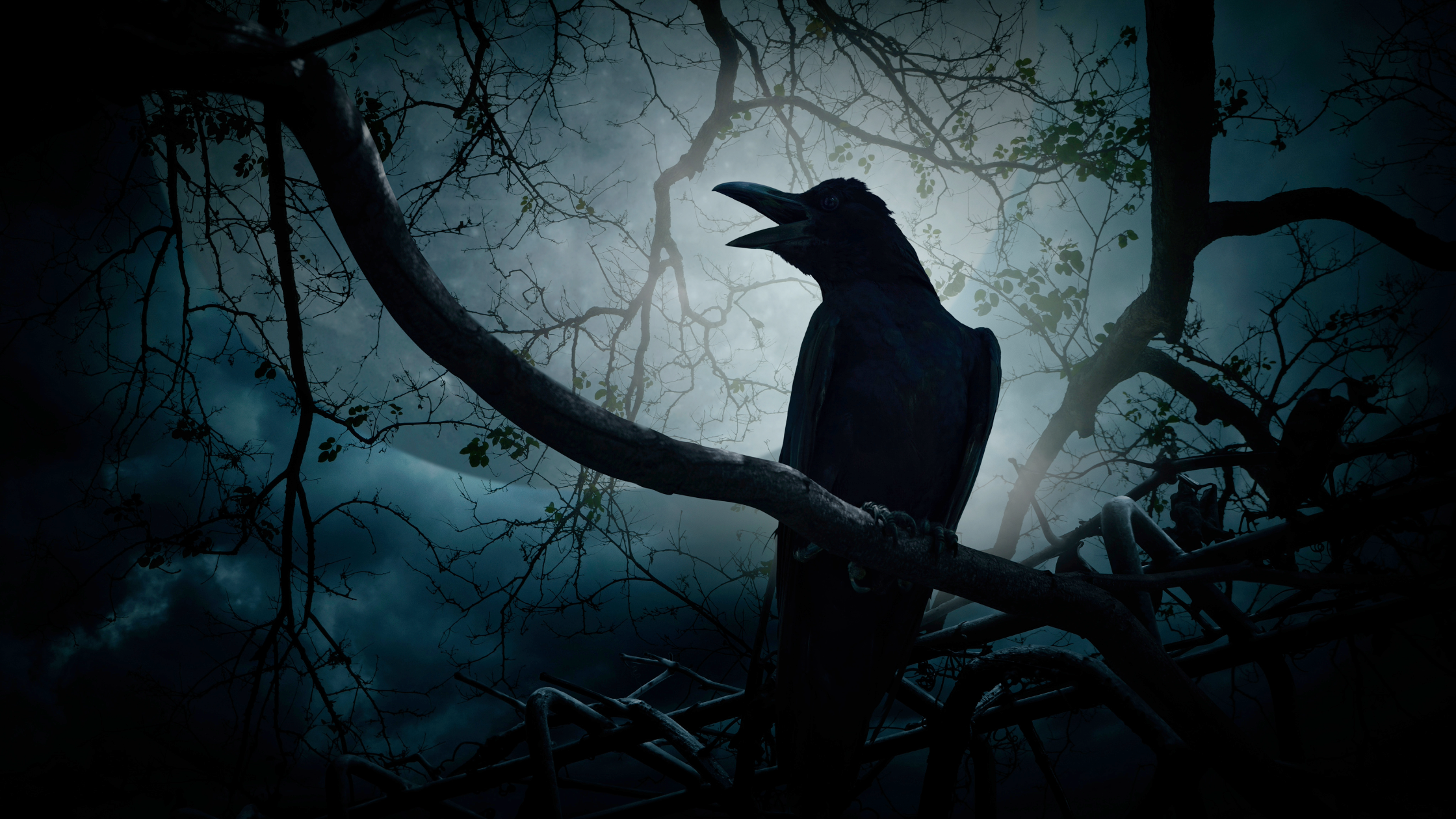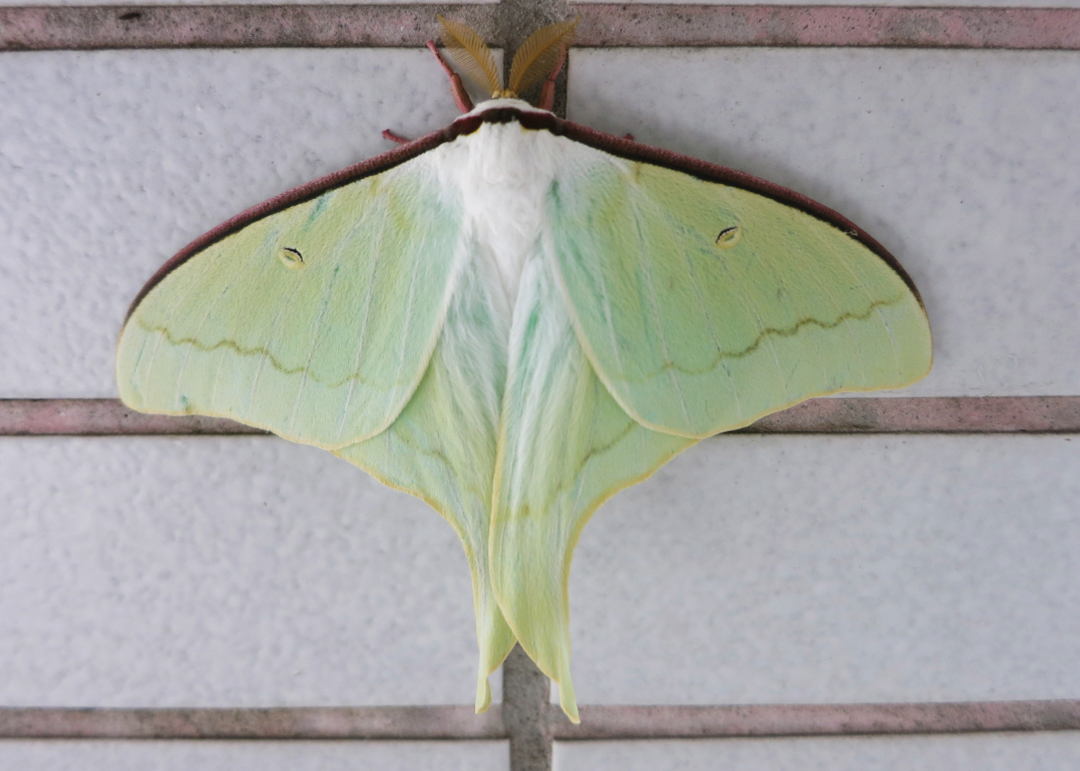Welcome to Mothing 101’s session “Moths in Japan.” So many moths, so little time to put a blog post together. There are whole books written about this topic that making a short blog post is a daunting task. I love listicle-type articles so it seemed easiest to chose some moths you might commonly encounter in Japan. But this left out a few favorites and some pesky villains, so I made room for them. This post wraps up with some Japanese vocabulary for moths.
The Most Common Moths in Japan
In a world full of dramatic moths, why focus on moths in Japan? Simple. I live in Tokyo and I was curious about the moths around me, et voila! Which moth is most common? Honestly, hard to say. I couldn’t find information I found reliable about the top 5 or top 10. I ended up picking the most likely and interesting candidates. Here is my “selected” list of moths you are likely to encounter if you come to Japan.
Japanese Silk Moth (Bombyx mori)

Image credit: lifeonwhite (Adobe Stock)
- Japanese Name: カイコガ (Kaikoga)
- Size: Wingspan approximately 7–12 cm.
- Description: white and fluffy moth with, feather antennae
- Nocturnal: active during day
- Habitat: It’s a domesticated species so you’ll find them at silkworm farms rather than the wild
Japanese Luna Moth (Actias aliena)
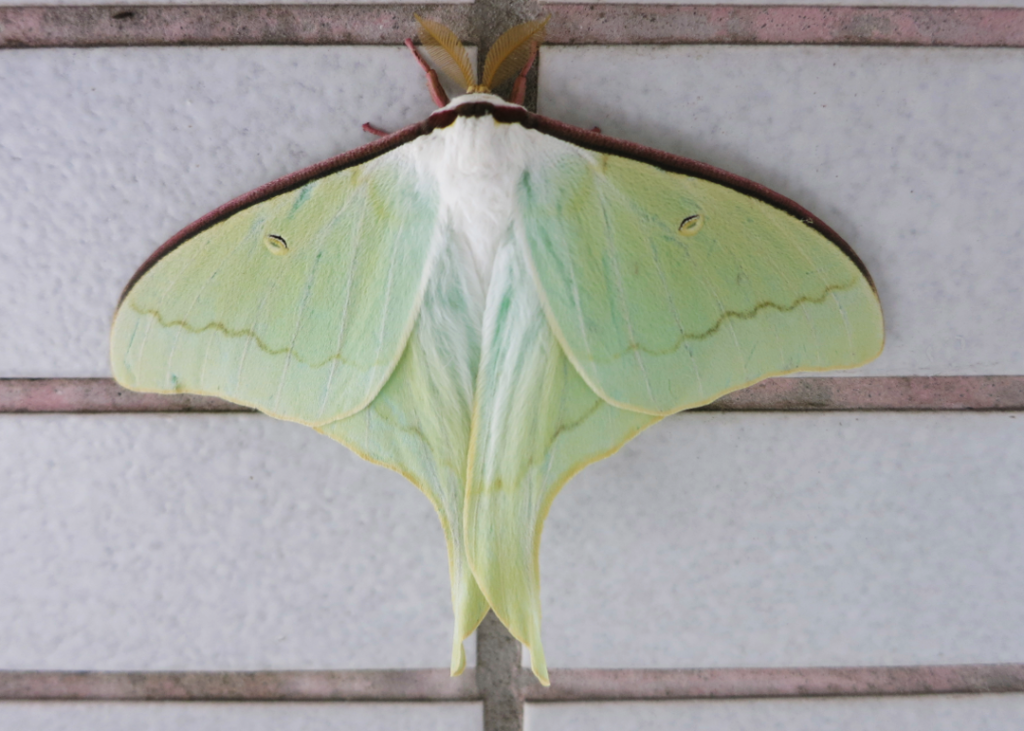
- Japanese Name: オオミズアオ (Ōmizuao)
- Size: Wingspan 8–10 cm.
- Description: green, more vivid pink and white markings compare to Actias selene.
- Nocturnal: Yes
- Habitat: Deciduous forests, wooded areas, and gardens.
- Factoid: Formerly Actias artemis. Related Actias selene has more subdued colors and found more commonly in other parts of Asia.
White Ermine Moth (Spilosoma lubricipeda)

- Japanese Name: シロモンシロチョウガ (Shiromonshirochouga)
- Size: Wingspan approximately 4–5 cm.
- Description: white wings with black spots.
- Nocturnal: Yes
- Habitat: Gardens, grassy areas, open woodlands.
Common Lappet Moth (Kunugia undans)
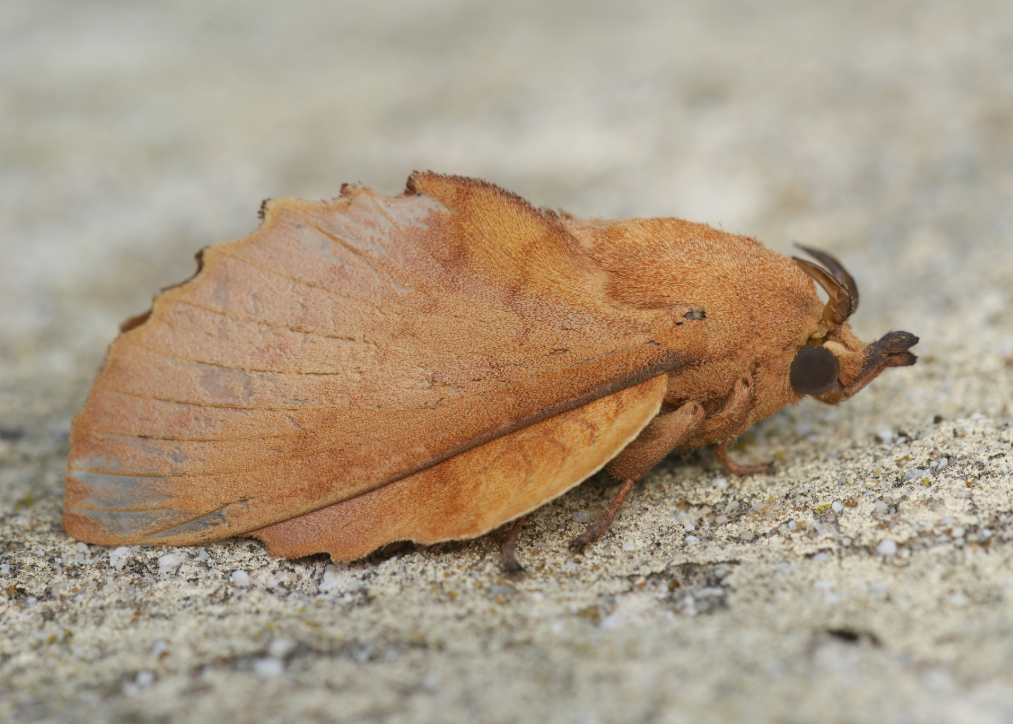
- Japanese Name: シモフリスズメ (Shimofurisuzume)
- Size: Wingspan 5–6 cm.
- Appearance: large, furry body, broad wings, feathery antennae
- Nocturnal: Yes
- Habitat: Wooded areas, forests, gardens.
Japanese Giant Silk Moth (Antheraea yamamai):
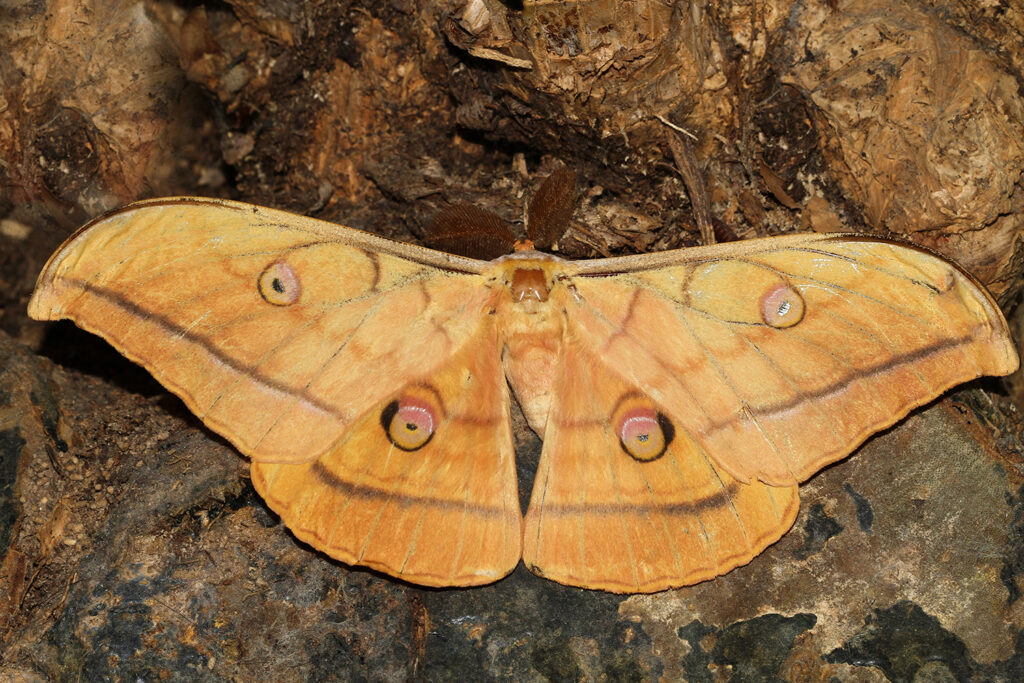
- Japanese name: カラタチガ (Karatachiga)
- Size: Wingspan 10–13 cm.
- Appearance:
- Nocturnal: Yes
- Habitat: Oak forests, wooded areas.
- Factoid: To make silk from this moth, cocoons are collected from the wild. This silk is called tussar silk. It has a slight gold sheen and short fibers. It’s less durable than cultivated silk.
Common Swallowtail Moth (Ourapteryx sambucaria):

- Japanese common name: ウスキツバメエダシャク (Usukitsubame edashaku)
- Appearance: pale yellow to creamy-white wings. Distinctive brown lines and an extension on the hind-wings gives it a swallowtail appearance
- Nocturnal: yes
- Habitat: various habitats, including woodlands, gardens, and areas with lots of vegetation.
Japanese Hawk Moth: Coffee Clearwing (Cephonodes hylas)
I see this one all the time in Tokyo. It loves blue cape wort flowers. I’m not sure if I’m identifying it correctly because at first I thought it was Macroglossum pyrrhostictum. Cephonodes hylas is often described as a green body but I’ve never seen one. The clear wings makes me think I’m right.
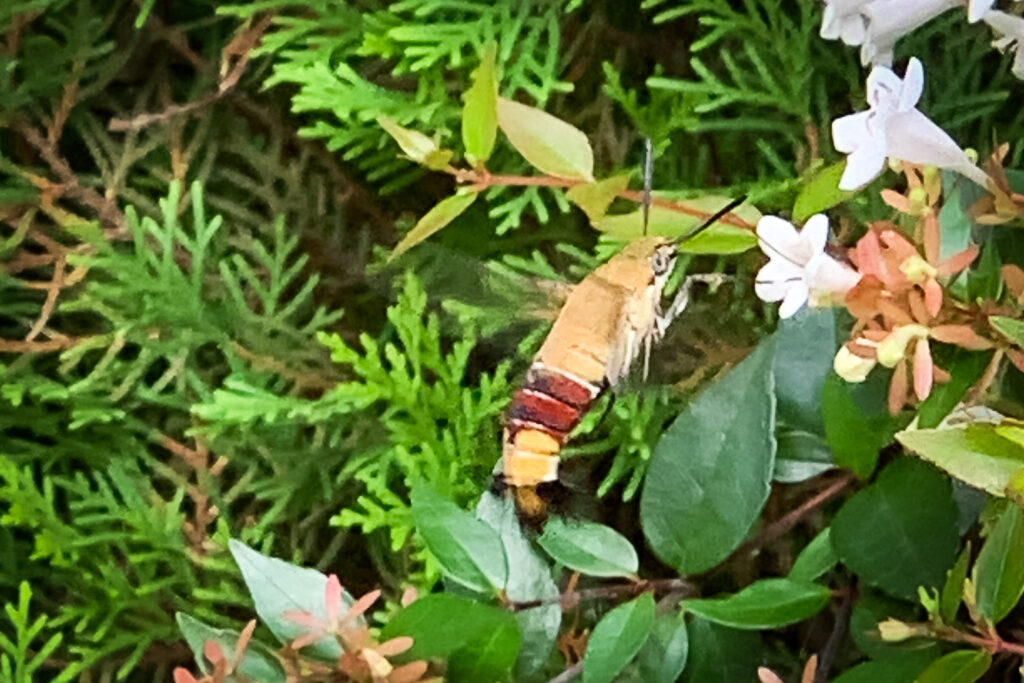
- Japanese name: オオスカシバ Oosukashiba (Cephonodes hylas)
- Wingspan: around 50–55 mm.
- Appearance: green or yellow with brown or red band on abdomend. Clear wings with dark edges.
- Habitat Preferences: Gardens and meadows with abundant flowering plants, and active during warmer weather
- Factoid: This moth hovers like a hummingbird while feeding on nectar. The European version, Macroglossum stellatarum, looks similar except for its grayish color
Infamous and Pesky
Gypsy Moth (Lymantria dispar japonica)
In Japan, the gypsy moth (Lymantria dispar japonica) is considered one of the peskiest moths due to its potential for deforestation and agricultural crop damage. The caterpillar is known as chadokumushi in Japan. The literal translation of this name is tea poison insect, but the name is more about emphasizing this caterpillar’s potential negative effect.
It’s the caterpillars who are the biggest culprits. They are hungry, hungry critters and are voracious eaters of leaves, especially hardwood trees. If the lack of leaves doesn’t kill the tree, it becomes weak and vulnerable to disease and other pests.

Another annoying thing about these insects is that the hairs from these caterpillars can cause skin irritation and even allergic reactions. (I couldn’t find a Lymantria dispar japonica image so I’m hoping this one looks similar.)
Story time: How I avoided a caterpillar hair shower thanks to a neighbor
One year, there was a huge infestation of gypsy moths. The caterpillars were everywhere. Even a bus stop with no greenery nearby was covered with wriggly, hairy caterpillars.
The tree in front of my house was infested with some kind of thin, hairy (not fluffy) caterpillar. My poor little tree was not doing well. During a conversation, I told a neighbor that I was going to save my tree by shaking it to knock the caterpillars off. I knew it wasn’t safe to touch hairy caterpillars so I was going to wear gloves.
Her eyes grew wide and she told me it was dangerous because the caterpillars’ hairs can shed, so even standing below a tree with this caterpillars risks contact and an allergic reaction.
I carefully backed away from the tree. Three nights later, a bunch of white things flew away from the tree. The tree survived and we haven’t had an infestation since.
How to Moth in Japanese
Perhaps this heading is a bit misleading because it’s just a few words in Japanese about moths and not how to actually speak in moth…hmm…
Not quite sure how a moth would sound or if we could even hear it but stay tuned for the answer to that question in the future.
| English | Japanese (romaji, kanji, hiragana) |
|---|---|
| Lepidotpera (the order of insects that include butterflies and moths | Rinshimoku (鱗翅目, りんしもく) |
| Moth | Ga 蛾 が |
| Body | Karada 体 からだ |
| Head | Atama 頭 あたま |
| Eyes | Me 目 め (pronounced like may) |
| Antennae | Shokkaku 触覚 しょっかく |
| Proboscis | Kyūkō 吸口 きゅうこう |
| Thorax | Kyōbu 胸部 きょうぶ |
| Abdomen | Fukubu 腹部 ふくぶ |
| Wings* | Hane 翅 はね |
| Legs | Ashi 足 あし |
| Insect egg Moth egg | Konchū ran 昆虫卵 こんちゅうらん Ga no tamago 蛾の卵 がのたまご |
| Caterpillar/larva refers to any insect in larval stage not just caterpillar | Yōchū 幼虫 ようちゅう |
| Pupa/chrysalis | Sanagi 蛹 さなぎ |
| Cocoon | Mayu 繭 まゆ |
| Night-flying – (nocturnal) | Yakōsei 夜行性 やこうせい Yakōsei no ga = nocturnal moth |
| Day-flying (diurnal) | Chūkōsei 昼行性 ちゅうこうせいChūkōsei no ga = diurnal moth |
| Pheromone | Feromon フェロモン (katakana word based on English) |
| Silk | Kinu 絹 きぬ |
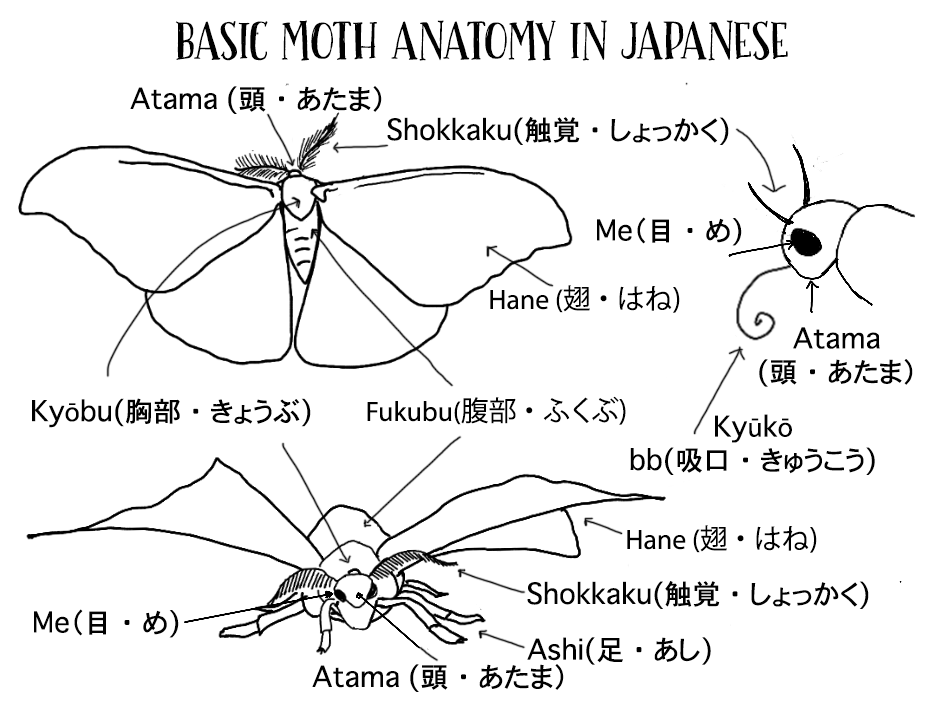
Next in Mothing 101
Next up is Moths, Myths and Magic. I’m excited for this part because we’re moving from biology to arts, literature and culture. Hope you’ll flutter on to the next article. If you want to see what Mothing 101 is about, go to Welcome to Mothing 101: A Very Basic Primer for the Moth-Curious and check out the “curriculum.”
